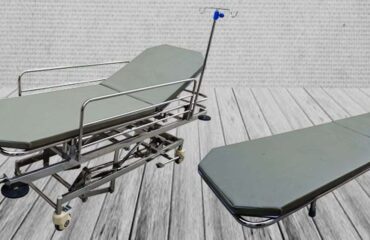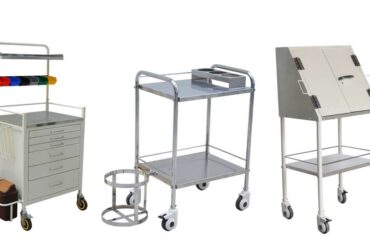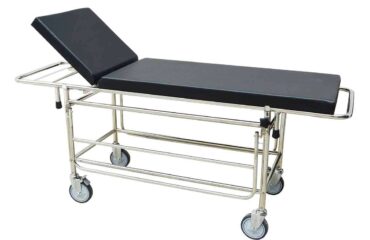An ambulance stretcher trolley, also known as a paramedic stretcher or emergency stretcher, is a specialized medical transport device used to safely move patients who are injured, ill, or immobile, particularly during emergency medical services (EMS) and ambulance transport. Here’s a detailed explanation
An ambulance stretcher trolley is a wheeled, collapsible, and adjustable platform designed to carry patients. It is used by paramedics and emergency medical technicians (EMTs) to transport patients from the scene of an incident to an ambulance and then into a hospital or emergency room.

Types of Ambulance Stretchers
Manual Stretcher
The most basic and commonly used stretcher, manually operated by emergency personnel.
Features:
- Adjustable height and backrest via levers or handles.
- Folding legs that retract as the stretcher is pushed into the ambulance.
- Lightweight frame (usually aluminum).
- Safety straps and side rails.
Uses:
- General ambulance transport.
- Cost-effective for standard EMS services.
Hydraulic/Pneumatic Stretcher
Uses hydraulic or pneumatic systems to lift and lower the stretcher with minimal effort.
Features:
- Push-button or lever-controlled lifting/lowering.
- Reduces physical strain on EMTs.
- Durable and stable under heavy loads.
Uses:
- Transporting heavy or immobile patients.
- Ideal for urban EMS systems.
Electric or Power-Operated Stretcher
Advanced stretcher with battery-powered controls for height and angle adjustments.
Features:
- Electric motor lifts the stretcher.
- Easy to operate with buttons or joystick.
- Rechargeable battery system.
Uses:
- High-end ambulances and critical care units.
- Long-distance patient transfers.
Scoop Stretcher
A scoop stretcher that splits into two longitudinal halves, allowing it to “scoop” a patient without needing to roll or lift them.
Features:
- Adjustable length.
- Locks at the center once patient is in place.
- Lightweight and compact.
Uses:
- Suspected spinal or pelvic injuries.
- Rescue from confined or awkward spaces.
Spine Board (Backboard)
A flat spine board used to immobilize the spine during patient transport.
Features:
- Rigid plastic or composite material.
- Strap slots for full-body immobilization.
- Compatible with cervical collars and head immobilizers.
Uses:
- Trauma cases with potential spinal injuries.
- Transport of unconscious patients.
Basket Stretcher (Stokes Litter)
A rigid stretcher with raised sides like a basket, designed for rescue in rough terrain.
Features:
- Made of metal or plastic mesh with a solid base.
- Can be carried, dragged, or hoisted.
- Often used with rope systems.
Uses:
- Mountain, water, or disaster rescue.
- Helicopter or rope-based extractions.
Flexible Stretcher (Soft Stretcher)
Made of durable fabric or plastic, it can be rolled or folded for easy storage.
Features:
- Handles on sides for team carrying.
- Extremely lightweight and compact.
- May not provide rigid support.
Uses:
- Emergency evacuation.
- Transferring patients in tight spaces.
Bariatric Stretcher
Specially designed for obese or bariatric patients.
Features:
- Higher weight capacity (up to 300–450 kg or more).
- Wider frame and reinforced structure.
- Often includes power-lift functionality.
Uses:
- Ambulances dealing with bariatric emergencies.
- Hospitals specializing in obesity treatment.
Neonatal/Pediatric Stretcher
Designed specifically for transporting infants and children safely.
Features:
- Smaller in size with special restraint systems.
- May include incubator mounts for neonates.
- Cushioning and shock absorption features.
Uses:
- Neonatal Intensive Care Unit (NICU) transport.
- Pediatric emergency response.
Benefits of Ambulance Stretchers
Here are the detailed benefits of ambulance stretchers, covering medical, operational, and safety advantages in emergency healthcare and patient transport:
Safe Patient Transport
- Minimizes injury risk during movement, especially for trauma patients.
- Reduces unnecessary movement of limbs or spine, crucial in accidents or fractures.
- Ensures patients are securely strapped and supported during transfer to ambulance or hospital.
Improved Patient Comfort
- Padded mattresses and adjustable backrests enhance comfort during transport.
- Position adjustments (e.g., reclining, semi-Fowler) help accommodate breathing difficulty, spinal alignment, or unconscious states.
- Smooth-rolling wheels and shock absorbers reduce vibrations and jerks.
Efficient Emergency Response
- Quick loading/unloading systems (e.g., folding legs, height adjustment) save precious seconds in critical situations.
- One-person or two-person operation enables rapid deployment even in limited manpower conditions.
Reduces Rescuer Fatigue and Injury
- Manual, hydraulic, or electric lift mechanisms reduce physical strain on paramedics.
- Limits the need for manual lifting or carrying, minimizing the risk of back or joint injuries in medical staff.
Versatility Across Environments
- Works in diverse emergency conditions: roadside accidents, homes, buildings, disaster zones, etc.
- Specialized stretchers like scoop, basket, or spine boards allow access in confined, uneven, or rough terrains.
Enhanced Patient Safety
- Equipped with safety belts, side rails, and locking wheels to prevent patient falls or movement during transit.
- Spinal immobilization attachments reduce the risk of worsening injuries during movement.
Adaptability for Various Patients
- Different stretcher types serve children, obese individuals, trauma victims, or critically ill patients.
- Some have built-in incubator supports or pediatric restraints for neonates and children.
Compatibility with Ambulance Systems
- Designed to be easily loaded into ambulance bays with automatic locking mechanisms.
- Foldable designs make storage and transition inside emergency vehicles seamless.
Durability and Hygiene
- Made with corrosion-resistant materials (like stainless steel or aluminum) that last through rugged use.
- Waterproof and disinfectant-friendly surfaces ensure high hygiene and infection control standards.
Supports Medical Procedures En Route
- Some stretchers allow for IV pole attachments, oxygen holders, and monitoring equipment.
- Stable base allows basic care or monitoring to continue while in motion.


